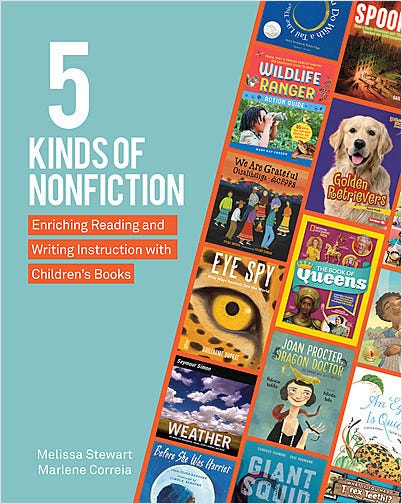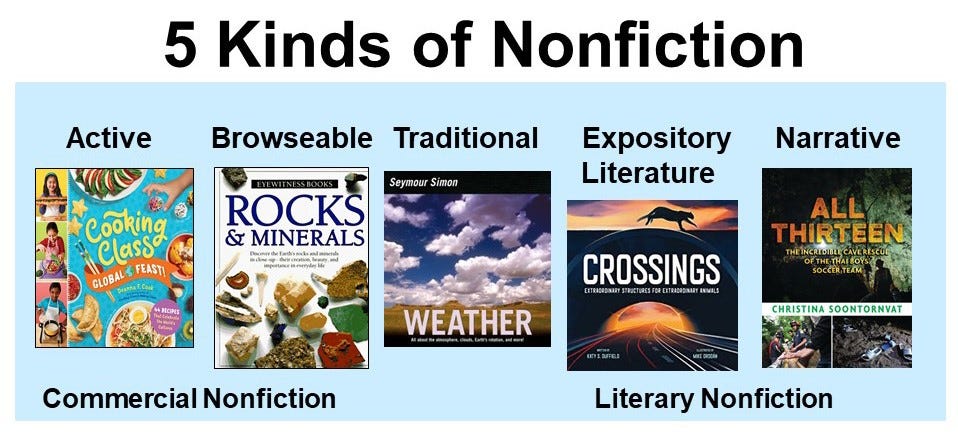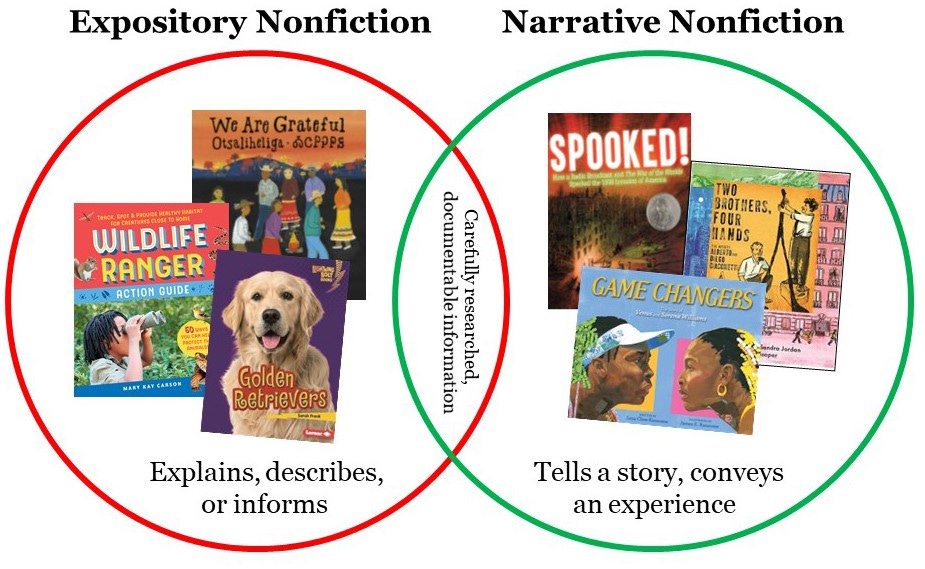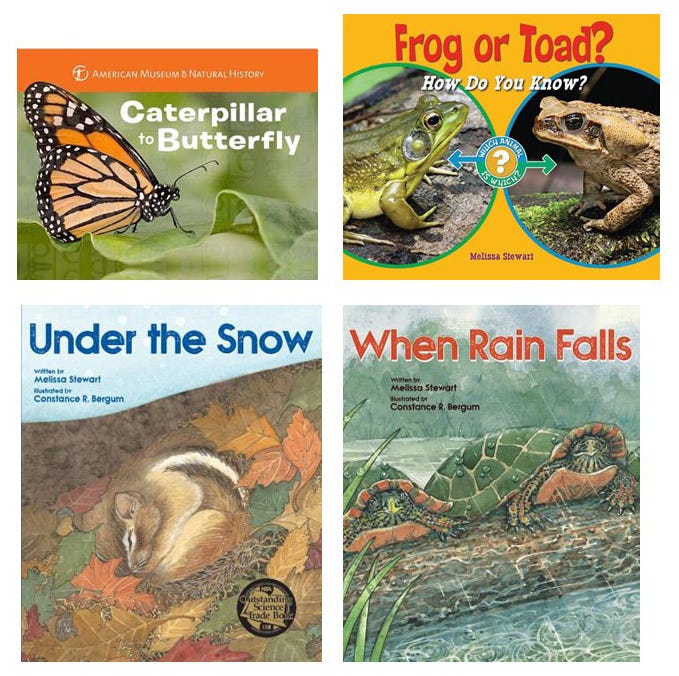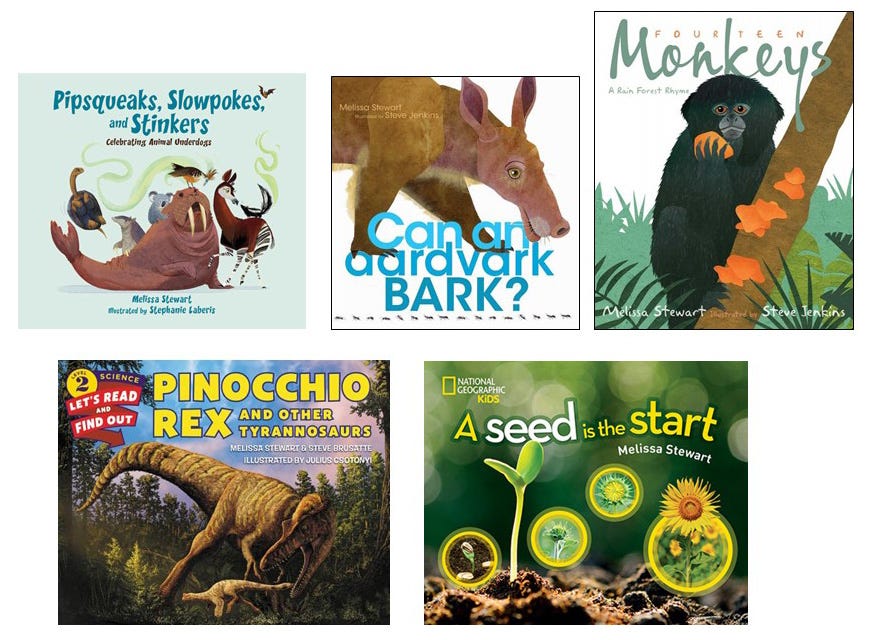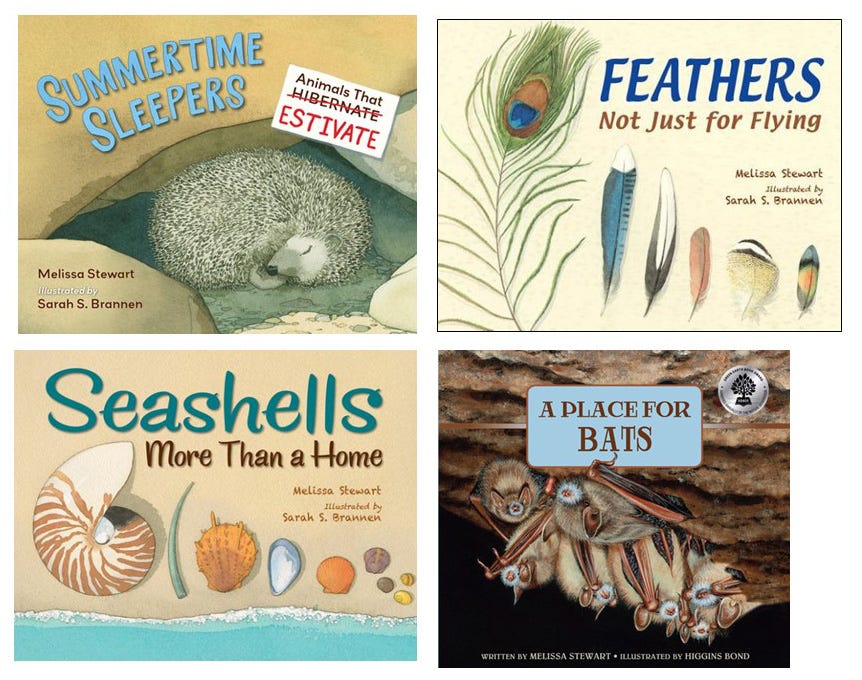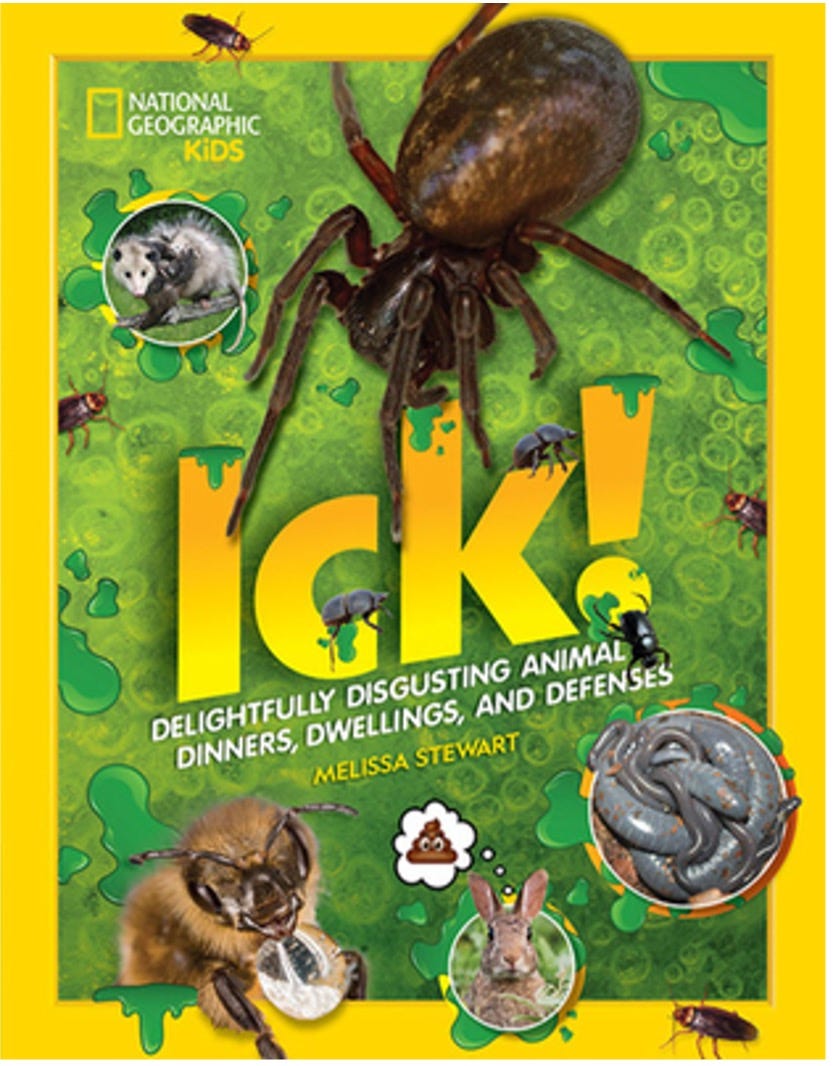(How) Can we read? An interview with Melissa Stewart
On the importance of nonfiction for children
In Notes From the Reading Nook: November 9 (2021), I had a kind of public epiphany: first, despite our enormous children’s library at home and my focus on building a family culture of reading, I hadn’t done justice to nonfiction at all. And second, nonfiction is a significant component — maybe even the key for some — to unlocking the interest of many readers.
This two-fold realization was thanks entirely to Melissa Stewart, a prolific children’s nonfiction author who has done a ton of professional work developing the 5 Kinds of Nonfiction (or 5KNF) classification system, which is not only helpful for understanding children’s books but also why it’s important to offer readers a variety of texts. (I mean, this sounds obvious, but diving deep into Stewart’s research and findings was eye-opening for me and has genuinely changed the way I approach both our library and what I am offering to my kids.)
And, she’s got chops: in addition to an education in science and nearly a decade of work as a children’s book editor, she’s the award-winning author of no less than 180 science books for children. She has written everything from board books for preschoolers to resources guides for educators, and people, she knows her stuff.
I wrote back in November that the topic of children’s nonfiction “grabbed my attention to a degree that has somewhat startled me,” to the point where I reached out to Stewart asking to pick her brain, and she said yes. (I feel so grateful to live in a world where I can type some rendered text into a glowing white box, make an ask, and the answer comes back yes.)
Without further ado, Melissa Stewart (and a little of me, but mostly Stewart).
First, let’s talk about nonfiction. You’ve done a lot of research about kids’ reading preferences, and it has yielded some results that, I think, contradict long-held assumptions about the love of stories and storytelling. Could you talk about that?
Adults selecting books for kids show a documented inclination towards fiction. People assume that kids like stories and will find nonfiction boring. There was even a Washington Post column asking, “Will my grandkids still love me if I buy them nonfiction?” In response to this misguided attitude, Heather Simpson, Chief Program Officer of the global literacy non-profit organization Room to Read, has said, “Children want their nonfiction books; adults may be their barriers.”
Study after study has shown that the majority of elementary-aged children enjoy nonfiction as much as or more than fiction. Here are some of the things students are saying:
“I like nonfiction because you gain knowledge. Then you ask more questions.” (Asher, fourth grader)
“Nonfiction is better than fiction because it has real, helpful facts about life.” (Kelsey, fourth grader)
“I like that nonfiction books really make you think about things for a while and then sometimes your thinking changes.” (Ryan, fifth grader)
And, really, why should comments like these be a surprise? In the adult publishing world, nonfiction sales are strong because when readers have the power to select their own books, they often choose nonfiction.
Humans love facts, stats, ideas, and information. It’s what makes the TV show Jeopardy! so popular, and it’s the reason the Guinness Book of World Records is a perennial bestseller.
So the question is: Why do adults have this misconception about children’s nonfiction? It may be that they have dreaded memories of stodgy textbooks and uninspired nonfiction survey titles from their own childhoods. Perhaps they aren’t aware of the incredible array of nonfiction books available today. That’s why I’m trying to spread the word about how much nonfiction for kids has changed in recent years. Today’s books are carefully crafted to excite, inspire, and engage young readers.
How can grownups—parents, educators, librarians, basically anyone with children in their life—support their growing nonfiction readers? I have an enormous children’s library at home, I write a newsletter about books and reading, yet I’ll admit I feel a bit daunted as to how to offer nonfiction and set up a good nonfiction experience, if you will, for my kids.
When it comes to nonfiction, content is king. It’s all about handing a child a nonfiction book on the exact topic they find most fascinating. That’s why Marlene Correia, professor of literacy educator and co-author (with me) of 5 Kinds of Nonfiction: Enriching Reading and Writing Instruction with Children’s Books, created a Book Match Survey. It can help teachers, librarians, and parents pinpoint the topics that interest kids as well as the kind(s) of nonfiction they gravitate toward.
In the 5 Kinds of Nonfiction, we break down the wide world of nonfiction into five categories (active, browsable, traditional, expository literature, and narrative) and describe the characteristics of each type. We also explain how each kind can be used most effectively in a school setting.
Once you get a sense of a child’s category and topic preferences, preview a variety of books with them and work with a children’s librarian to create reading ladders to help the child gradually build their nonfiction reading skills.
Even knowing what you do about reading preferences, do you think it’s important for children to have a varied reading diet? (Maybe another way of asking this is, what if my kid isn’t into nonfiction?)
Nonfiction can be written in two different styles—expository and narrative. Expository nonfiction explains, describes, and informs in a clear, straightforward way. Narrative nonfiction tells a story or conveys an experience. It reads just like fiction, except everything is 100 percent true. It has real characters, a real setting, and a traditional story arc.
Many children who seem uninterested in nonfiction will quickly change their tune if they have a chance to read a narrative nonfiction title on a topic they find fascinating. It’s a matter of meeting kids where they are and then helping them blossom and grow as readers as their skills improve and their interests evolve.
If a child loves fiction, they should have plenty of opportunities to read fiction, but in this age of state-mandated standardized tests, it’s important for a child’s literacy development to be exposed to a wide array of nonfiction too.
You’ve written over 180 science books for kids (let me pause for a second and say: WOW!) Could you recommend a title of yours (or a few) for each of the following age groups:
Babies and toddlers: Caterpillar to Butterfly, Sterling Publishing/American Museum of Natural History
Preschoolers: Under the Snow, Peachtree Publishing; When Rain Falls, Peachtree Publishing; Frog or Toad: How Do You Know?, Enslow Publishing
Early elementary: Pipsqueaks, Slowpokes, and Stinkers: Celebrating Animal Underdogs, Peachtree Publishing; Can an Aardvark Bark?, Simon & Schuster; Fourteen Monkeys: A Rain Forest Rhyme, Simon & Schuster; Pinocchio Rex and Other Tyrannosaurs, HarperCollins; A Seed Is the Start, National Geographic
Late elementary: Summertime Sleepers: Animals that Estivate, Charlesbridge; Feathers: Not Just for Flying, Charlesbridge; Seashells: More than a Home, Charlesbridge; A Place for Bats, Peachtree Publishing
Middle grade: Ick! Delightfully Disgusting Animal Dinners, Dwellings, and Defenses, National Geographic
Lastly, could you recommend a few books by other nonfiction authors that have made you think, "This is so good it should be on every child’s bookshelf?"
Oh wow, that’s a hard question because there are so many fantastic nonfiction books, and every young reader is so different.
One thing I really want to stress is the importance of reading nonfiction aloud. It makes great bedtime reading for curious kids. So I’m going to include links to two reading lists—25 Great Expository Nonfiction Read Alouds and 25 Great Narrative Nonfiction Read Alouds. Invite the kids in your life to look at these lists and choose the ones on topics that appeal to them most.
Not gonna lie, folks — discovering and interviewing Melissa Stewart has impacted me so much it’s not a stretch to say she changed my life. Huge thanks to her for taking the time to answer my questions (hold my hand), and thanks to you lovely people for reading today.
For more information about Stewart’s work — including browsing her books by category, which I love — visit her website. (Educators, there’s a special section there just for you.) And be sure to seek out her books at your nearest library and bookstore.
Because “sometimes your thinking changes” is as good a reason I’ve ever heard to seek out a book, or a whole category of them. I’ll be seeking out more nonfiction right alongside you.
Sarah



